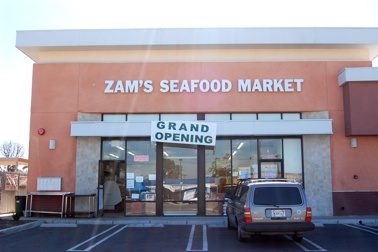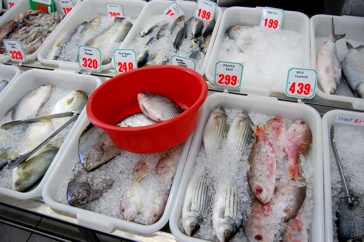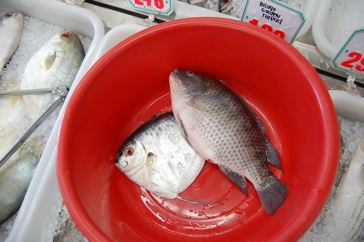Gyotaku (gyo=fish, taku=rubbing) was invented in the early 1800’s in Japan by the fishermen to record their catch. This was their livelihood (not sport fishing as we have today) and they could document the size and types of fish caught and still take it back to be sold or eaten. Also, certain fish in Japan are revered and they would take rubbings of these fish and then place them back in the water. Japanese fishermen took newsprint, ink and brush out to sea with them. On occasion, old newspapers printed with water-soluble ink were also used as the ink would bleed with the moisture from the fish and record its shape (a print) on the newspaper. Prints were brought back and displayed in the homes of the fishermen either on walls or in journals to be used as conversation pieces and to relate proud and heroic stories of the catch. Japanese fishing magazines still hold contests where the judging is done from Gyotaku’s. It has also developed into an art form; many created prints for their beauty, and added artistic elements.
-the above info taken from Artsedge (see link in sidebar)
Since we are doing printing through March I thought we might explore gyotaku. One of the most important things that has to be done in preparation of a lesson such as this is it has to be tried out at home first. Work out the bugs and figure out the pitfalls before you have 30 4th graders, some smelly fish, and a disaster on your hands!
So, it begins with a trip to the fish market. We are lucky to have a new market in the neighborhood that just opened up so off we went to Zam’s Seafood on the corner of Orange and Carson in Long Beach Ca.


a wide selection of fresh fish to choose from….looking for something that has some good textures and interesting
lines

I choose a tilapia and a moon fish-cost about $3.50

supplies collected-brush, rice paper, sumi stick and stone
paint the fish with the ink and press on the paper. the rice paper easily forms over the fish’s body

there it is! i think we will try a round with tempera paint and maybe some cheap paint rollers
but it looks like a “go” for printmaking month.
If you don’t have access to fresh fish Dick Blick has some plastic ones that you can order.



this is fabulous! the story, the fish, the whole thing. i want to prints from quilts, or my cat or something.
milo does NOT approve of cat printing….or “nekotaku” in japanese…….. he’s definitely against it! now quilt printing is another story….”kirutotaku”
wow- with all your stitching and texture there might be something there!
i’ve studied this a bit more and there is another form of gyotaku called “indirect gyotaku” printing which is sometimes done on silk using individual “tampos” where silk (or paper) is placed over the object (fish) and the tampos (loaded with color) are patted across the desired area bringing forth the texture on the silk….. hope i live long enough to try out all these things!
You might be interested in checking out Mineo Yamamoto’s site (http://www2a.biglobe.ne.jp/~gyotaku/) on gyotaku – he comes to Campbell River, British Columbia, Canada, every summer to give a workshop on the “indirect” method. I believe he also travels to the US for workshops. Anyway, my Mom & I did the workshop this August (http://burnishings.blogspot.com/2007/08/gyotaku-fish-printing-part-i.html) and it was great!
yes! i did come across some photos of his workshop on flickr -posted by someone who had taken one. fascinating-the indirect method. i’ll go take a look at your post -thanks for the link!
Pingback: gyotaku today « Elementary Art Exploration